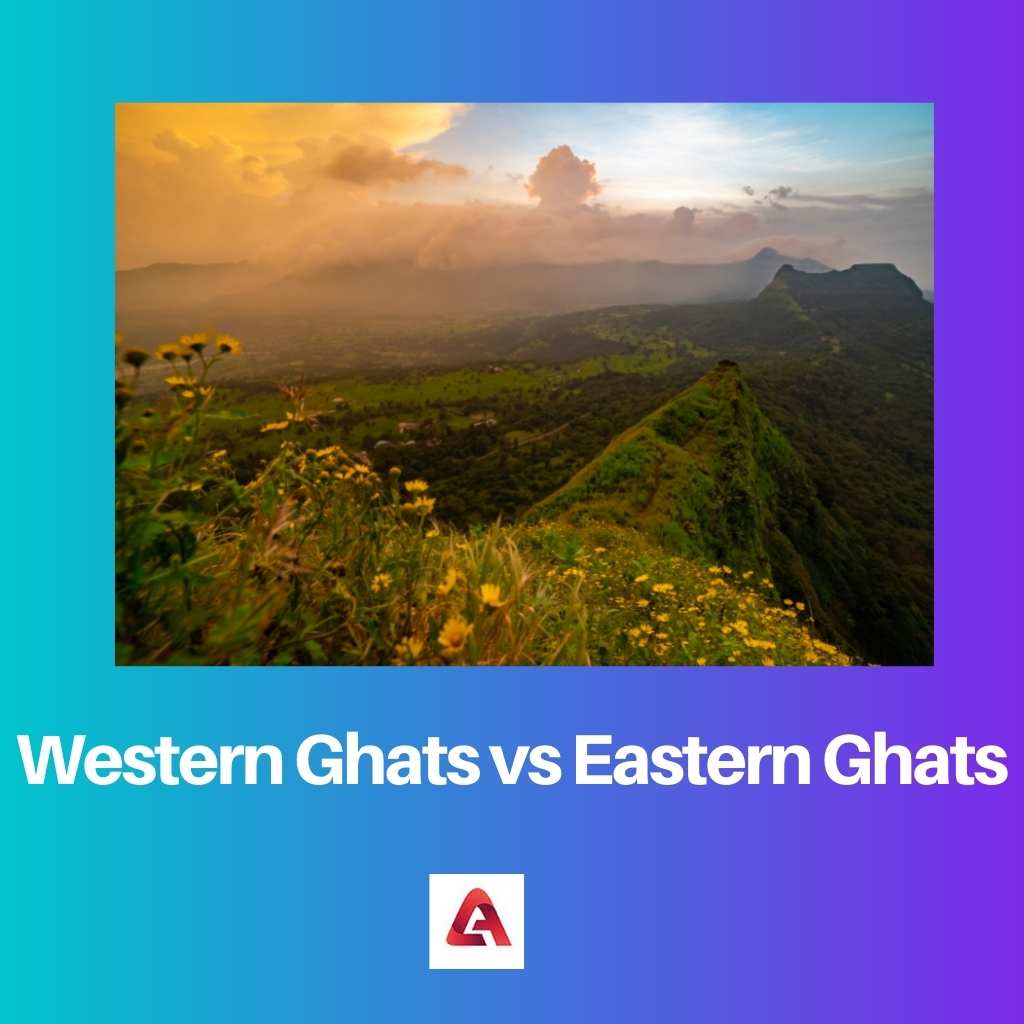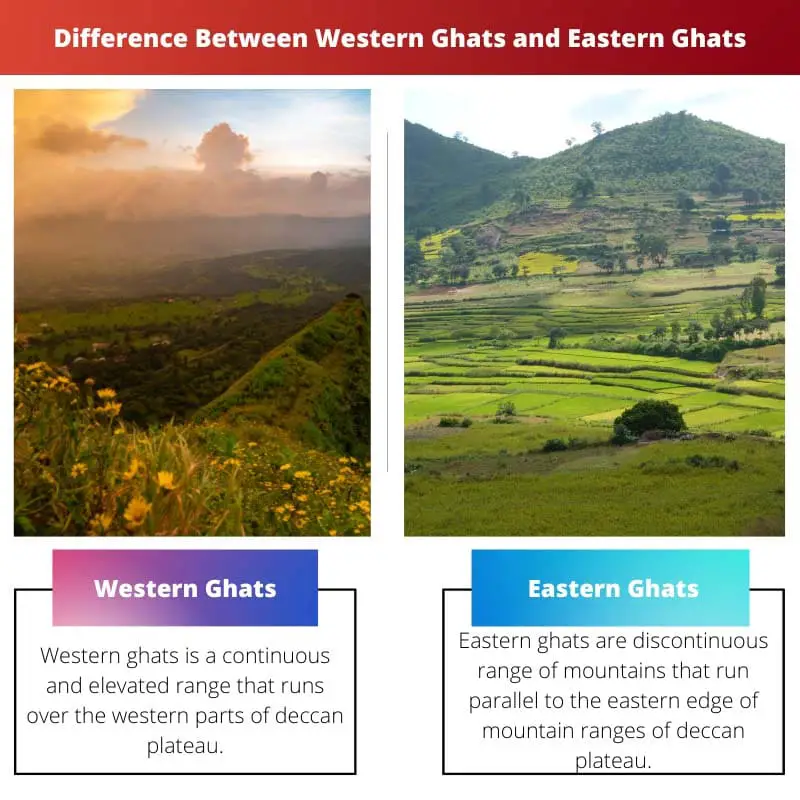The land of the world is divided into different types of regions, catteries, and ranges based on geographic differences. In the normal Hindi language, ghats mean mountain passes or river landing stairs.
Ghats are the two ranges of the mountain that form western and eastern ghats of Peninsular India of Deccan plateau.
As the name is self-explanatory western ghats and eastern ghats mark the western and eastern edges of Deccan plateaus that lie parallel to each other.
Key Takeaways
- The Western Ghats run parallel to India’s western coast, while the Eastern Ghats extend along the eastern coast.
- Western Ghats exhibit higher elevations and greater biodiversity than Eastern Ghats.
- The Western Ghats receive more rainfall due to their proximity to the Arabian Sea, fostering lush forests and numerous rivers.
Western Ghats vs Eastern Ghats
The Western Ghats are known for their rich biodiversity and importance as a source of water. The Eastern Ghats are known for their scenic beauty, diverse landscape, and historic significance. The Eastern Ghats’ range has a diverse landscape and it’s not continuous as the Western Ghats.

The Western Ghats play an essential role in hydrology and watershed management.
Due to a large amount of water accessible in this region, peninsular states have a population of 245 million people that rely only on this region for their water.
As a result, this region of the plateau has water support and the livelihoods of millions of people.
The eastern ghats form a broader mountain range that runs parallel to the east coast from central India to the south. It does not have a continuous road because of the large rivers and valleys, making travel difficult.
The plateau is a region of graded valleys with red sandy soil and due to erosion, there are isolated hills in this region.
Comparison Table
| Parameters of Comparison | Western Ghats | Eastern Ghats |
|---|---|---|
| Definition | Western ghats is a continuous and elevated range that runs over the western parts of deccan plateau. | Eastern ghats are discontinuous range of mountains that run parallel to the eastern edge of mountain ranges of deccan plateau. |
| Local Names | Nilgiris hills in Tamil Nadu, Sahyadri in Maharashtra, cardamon hills and anaimalai hill in Kerala. | Purva ghat, Mahendra parvat. |
| Height Range | 900-1600 meters | 600-900 meter |
| Continuity | The Western Ghats are continuous in nature and have more range of mountains. | Eastern ghats are discontinuous in nature and have the low height of mountain ranges. |
| Crop Grow | Coffee | Rice |
| Soil | The soil of western ghats are highly fertile. | The soil of eastern ghats are not very much fertile. |
| Major Rivers | Krishna, Brahmani, Godavari, Kaveri, Tungabhadra and Subarnarekha. | Godavari, Kaveri, and Krishna, kabini, tunga, Bhadra, malaprabha, ghataprabha, and Hemvathi. |
What is Western Ghat?
The Sahyadri Hills, as the Western Ghats are known, are popular for their spectacular grandeur of flora and animals of diverse varieties. Western ghats mainly cover the western edges of the Deccan plateau.
There are several mountain chains that stretch for 30-50 kilometers. Their steep seaward slopes are sculpted into canyon-like valleys by streams, yet their gentle landward slopes give way to vast, mature valleys.
The range stretches north to the Tapti River and south almost to India’s southernmost point, Cape Comorin. The Western Ghats is one of the world’s top eight biodiversities and are known for their breathtaking beauty.
The Palghat Gap divides the Western Ghats from its southern extension, known as the Palghat. The orographic rainfall caused by the western ghats results in a lot of rain, which boosts the fertility of the land.
The fertility in this area is so high that the highly staple food name rice grows here which has a high demand in the region. It is signified as UNESCO World Heritage Site.
Anaimudi, at 2695 meters is the highest peak in the Western Ghats and it is known as the South Indian Everest. Anaimudi which means elephant’s head.
It is situated on the boundary of Kerala’s Ernakulam and Idukki districts. In Maharashtra, the foothill region of this ghat is knowns as Desh while in Karnataka, it is known as Malanadu.

What is Eastern Ghat?
Eastern ghats spread parallel to the eastern coastal plains of the Deccan plateau. The Javadi and Shevaroy hills are part of the Eastern Ghats, which combine with the Western Ghats beyond.
The slopes of the mountains have scant trees with valuable timber. The Eastern Ghats are the oldest ghats that have complex geographic structures and the break of the ancient supercontinent of Rodina lies here.
The slopes here have a variety of forest types, primarily sparse woodland with good timber that can be used for a variety of uses.
The Eastern Ghats are home to mostly tropical moist deciduous flora, which includes high-value wood, medicinal, and commercial species.
Some notable summits may be found here, including Arma Konda, Sinkram Gutta, and Gali Konda. Jindhagada, located in Andhra Pradesh, is the highest peak among these ghats.
Metamorphic gneisses, quartzite rock, Charnockites, granite gneiss, chondrites, and granite gneiss, formations make up the Eastern Ghats.
Limestone, bauxite, iron ore, and a variety of minerals and ores can all be found in large quantities here. The Madugula Konda Range is found in the Eastern Ghats’ northernmost region.
The Madugula Konda range is higher than the Maliyas, with heights ranging from 1100 to 1400 meters.

Main Differences Between The Western Ghats and The Eastern Ghats
- Western ghats run parallel to the western coast, while eastern ghats run parallel to the eastern coast. The soil found in eastern ghats is highly fertile, while western ghats do have fertile soil.
- Western ghats are higher in elevation than eastern ghats, making passage through them difficult.
- Western ghats are continuous in nature without any major breaks while, eastern ghats are not continuous which makes it difficult to travel.
- There are no important rivers that cut across the Western Ghats. On the other hand, the major rivers of eastern ghats are Godavari, Mahanadi, Kaveri, and Krishna.
- Western ghats are continuous and are high in elevation while the Eastern Ghats are uneven and disjointed and they are at a lower elevation, averaging 600 meters.

Reference
- https://scholar.archive.org/work/264jg2wb7jfdfltlunzkg3prsu/access/wayback/http://www.zoosprint.org/ZooPrintJournal/2003/April/1067-1070.pdf
- https://scholar.google.com/scholar?hl=en&as_sdt=0,5&qsp=5&q=%22western+ghats%22+forest&qst=ib
